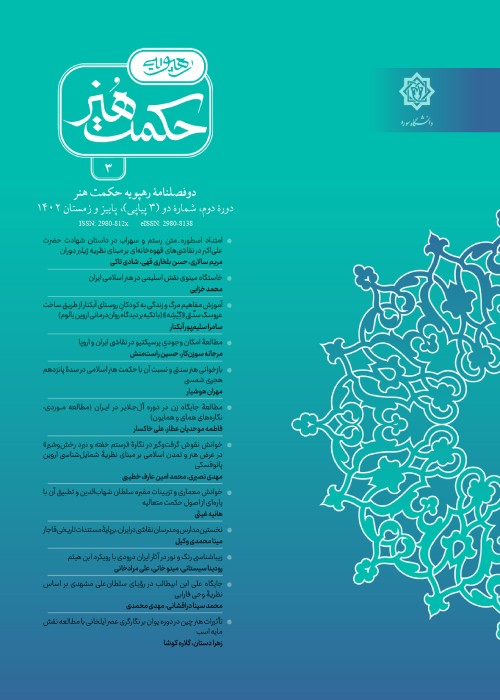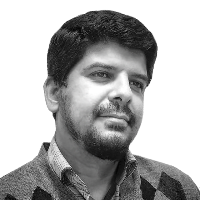On Schuon's "Traditional Art": An Analytical Review
Author(s):
Article Type:
Research/Original Article (بدون رتبه معتبر)
Abstract:
Some scholars of the last century have offered a specific definition of "Tradition" and have become known as Traditionalists. Their main concern is the revival of the Tradition in today's societies. Traditional civilization is vital to them, and they seek to traditionalize all things, including art. But the concept of "Traditional art" does not seem obvious and precise, like in other cases described as Traditional. This issue has made it always controversial to clarify the nature and characteristics of "traditional art". Frithjof Schuon, as one of the leading figures of the Traditionalist movement, has made many claims in this regard. The purpose of this paper is to restructure his views on Traditional art. Achieving a definition of "Traditional art" helps us first distinguish a Traditional artwork from another. Second, the artist can use this definition to create Traditional artworks.One of the ways to investigate philosophical issues is to clarify concepts by providing the necessary and sufficient conditions. This method has been widely used in the contemporary philosophy of art. The present study, which uses the descriptive-analytical method, tries to introduce the necessary and sufficient conditions for a supposed work of art to be placed under the "Traditional art" category by referring to Schuon's works. To achieve this, we first extract the features of Traditional art from Schuon's point of view as much as possible. Once we identify these characteristics, we decide which one we can choose as necessary or sufficient for defining traditional art.From Schuon's point of view, the main feature of Traditional art is that the artwork is, in fact, an expression of the intellectual realities of the higher worlds (directly or indirectly). In his view, Traditional artwork, like sacred texts, originates from revelation and indicates indescribable spiritual matters. Not only does he consider the origin of Traditional art to be divine, but he also considers the form of the works to correspond to the same divine truths. Symbolism is a feature that exists in both pure nature and sacred art. Traditional artwork is a symbolic expression of transcendent truths. He argues that symbolic art is inherently related to intellectual reasoning. There is a symbolic relationship between rational intuition and perceptual forms.Another characteristic that Schuon constantly points out is that Traditional artwork is not a product of the artist's mind, and therefore innovation has no meaning in it. He believes that all forms, even insignificant ones, can only be considered human creation secondarily. They come firstly from the same superhuman source that is the source of all Traditions. The following characteristic of traditional art is its functionality. This feature means that art is never created solely for pleasure and artistic aspects in a Traditional civilization. Such a view is clearly in contrast with the "art for art's sake" theory, and Schuon has repeatedly criticized this theory in his work, calling it even the most foolish and deviant idea. The last feature that he says about Traditional art is the conformity of form, raw materials, and symbolism with the rules of Traditional art.Accordingly, by putting these features together, we come to the first version of the definition of Traditional art. In this definition, the concept of "Traditional Art" has five conditions. This definition tells us that if something wants to be a Traditional artwork, it must have all five above characteristics. If something has a combination of these characteristics, it is enough to consider it a Traditional artwork. By further elaborating on each of these five characteristics, we conclude that perhaps only the first condition (expression of intellectual realities) can be considered a sufficient condition. Thus we propose the second version of the definition so that X is a work of art only if it is an expression of intellectual realities.After examining the second version, it becomes clear that it also has a fundamental problem: Schuon indeed believes that all Traditional artworks meet almost all of the above conditions (Every Traditional artwork he has introduced has such condition). Still, it remains to be seen whether the conditions (2) to (5), necessarily have a relation with condition (1)? Knowing that all the Traditional works introduced by Schuon meet the five conditions mentioned above, is it possible to conclude that if something has the first condition, it necessarily has the other conditions as well? Examining this case leads us to the third version of the definition of Traditional art.According to this version, I propose these three conditions: "symbolic expression of intellectual realities", "functionality," and "conformity of form, raw materials, and symbolism with the rules of Traditional art". From Schuon's viewpoint, these conditions can be considered necessary and jointly as a sufficient condition for an artwork to be "Traditional". Finally, with such a theory in hand, one can better explain Schuon's opinions about art and criticize his claims.
Keywords:
Language:
Persian
Published:
Journal of Rahppoye, Hekmat-e Honar, Volume:1 Issue: 1, 2022
Pages:
61 to 70
https://magiran.com/p2519496
دانلود و مطالعه متن این مقاله با یکی از روشهای زیر امکان پذیر است:
اشتراک شخصی
با عضویت و پرداخت آنلاین حق اشتراک یکساله به مبلغ 1,390,000ريال میتوانید 70 عنوان مطلب دانلود کنید!
اشتراک سازمانی
به کتابخانه دانشگاه یا محل کار خود پیشنهاد کنید تا اشتراک سازمانی این پایگاه را برای دسترسی نامحدود همه کاربران به متن مطالب تهیه نمایند!
توجه!
- حق عضویت دریافتی صرف حمایت از نشریات عضو و نگهداری، تکمیل و توسعه مگیران میشود.
- پرداخت حق اشتراک و دانلود مقالات اجازه بازنشر آن در سایر رسانههای چاپی و دیجیتال را به کاربر نمیدهد.
In order to view content subscription is required
Personal subscription
Subscribe magiran.com for 70 € euros via PayPal and download 70 articles during a year.
Organization subscription
Please contact us to subscribe your university or library for unlimited access!



